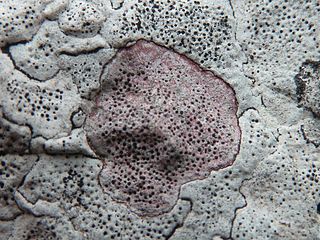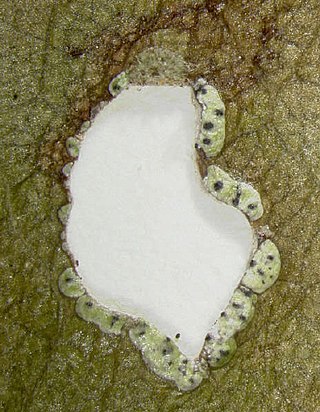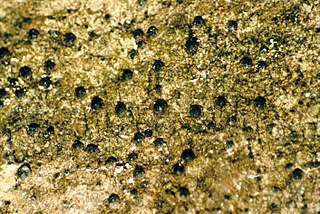
The Lecanoraceae are a family of lichenized fungi in the order Lecanorales. Species of this family have a widespread distribution.

The Gomphillaceae are a family of lichen-forming fungi in the order Graphidales. Species in this family are found mostly in tropical regions.

The Pyrenulales are an order of ascomycetous fungi within the class Eurotiomycetes and within the subphylum Pezizomycotina.
Clathroporina is a genus of lichenized fungi in the family Trichotheliaceae. It was circumscribed by Swiss lichenologist Johannes Müller Argoviensis in 1882.

Lopadium is a genus of lichen-forming fungi in the monotypic family Lopadiaceae, which is in the order Lecideales. The genus contains 10 species. Lopadium was circumscribed by German lichenologist Gustav Wilhelm Körber in 1855.
Seirophora is a genus of lichen-forming fungi in the family Teloschistaceae. It has eight species. The genus was circumscribed by Czech lichenologist Josef Poelt in 1983, with Seirophora magara assigned as the type species. Several species were transferred to Seirophora in 2004 when the genus was emended by Patrik Frödén and Per Lassen to include some species segregated from Teloschistes.

Bagliettoa is a genus of lichen-forming fungi in the family Verrucariaceae. The genus was circumscribed by Italian lichenologist Abramo Bartolommeo Massalongo in 1853. Bagliettoa species are endolithic, growing between the grains of solid rock.

Gyalecta is a genus of lichen-forming fungi in the family Gyalectaceae that contains 50 species. Gyalecta was circumscribed by lichenologist Erik Acharius in 1808. It forms associations with Trentepohlia algae.

Fuscidea is a genus of crustose lichens in the family Fuscideaceae. It has about 40 species. The genus was circumscribed in 1972 by lichenologists Volkmar Wirth and Antonín Vězda, with Fuscidea aggregatilis assigned as the type species.

Hypocenomyce is a genus of lichen-forming fungi in the family Ophioparmaceae. Species in the genus grow on bark and on wood, especially on burned tree stumps and trunks in coniferous forest. Hypocenomyce lichens are widely distributed in the northern hemisphere.
Arthopyrenia is a genus of fungi in the family Trypetheliaceae. It was formerly classified in the eponymic family Arthopyreniaceae, but molecular phylogenetics studies showed that the type species, Arthopyrenia cerasi, was a member of the Trypetheliaceae.
Vezdaea is a genus of crustose lichens in the monotypic family Vezdaeaceae, which itself is the only taxon in the order Vezdaeales. The genus was circumscribed by Elisabeth Tschermak-Woess and Josef Poelt in 1976. The genus name honours Czech lichenologist Antonín Vězda (1920-2008).

Strigula is a genus of lichen-forming fungi in the family Strigulaceae. The genus was circumscribed in 1823 by English mycologist Elias Magnus Fries.

Scoliciosporum is a genus of lichens in the family Scoliciosporaceae.

Sporastatia is a genus of crustose lichens in the family Sporastatiaceae. It has four species. Sporastatia lichens are long-lived species that grow on siliceous or weakly calcareous rocks in arctic and alpine locales.
Pachyascus is the sole genus in the family Pachyascaceae. It contains a single species, the lichen Pachyascus lapponicus. Both the genus and species were described as new to science in 1968 by lichenologists Josef Poelt and Hannes Hertel. P. lapponicus was originally collected from Lapland, a province in northern Sweden. The lichen has several unusual characteristics: it grows exclusively along with the rock moss Andreaea, it bears goniocyst-like parts and produces tiny apothecia that stand in the leaf axils of the moss, and it has thick asci.

Thelenella is a genus of lichen-forming fungi in the family Thelenellaceae. It has 30 species. The genus was circumscribed by Finnish lichenologist William Nylander in 1855, with Thelenella modesta assigned as the type species.
Swinscowia is a genus of lichen-forming fungi in the family Strigulaceae. It has 34 species. Swinscowia was proposed in 2020 by lichenologists Shu-Hua Jiang, Robert Lücking, and Emmanuël Sérusiaux to contain non-foliicolous species that were isolated from bark and rocks. Swinscowia jamesii, a species that was originally described in genus Geisleria, and later transferred to Strigula, is the type species of the genus. The genus name honours British lichenologist Dougal Swinscow, who originally described the type species in 1967.
Strangospora is a genus of lichen-forming fungi. It is the only genus in the family Strangosporaceae, which itself is of uncertain taxonomic placement in the Ascomycota. It contains 10 species.
Megalotremis is a genus of lichen-forming fungi in the family Monoblastiaceae. It has 16 species. The genus was circumscribed by Dutch lichenologist André Aptroot in 1991, with Megalotremis verrucosa assigned as the type species. Megalotremis is a pyrenolichen genus, meaning its species have perithecioid ascocarps: spherical or flask-shaped, sessile or partly immersed in the thallus, with a single opening (ostiole) and enclosed by a distinct wall.












